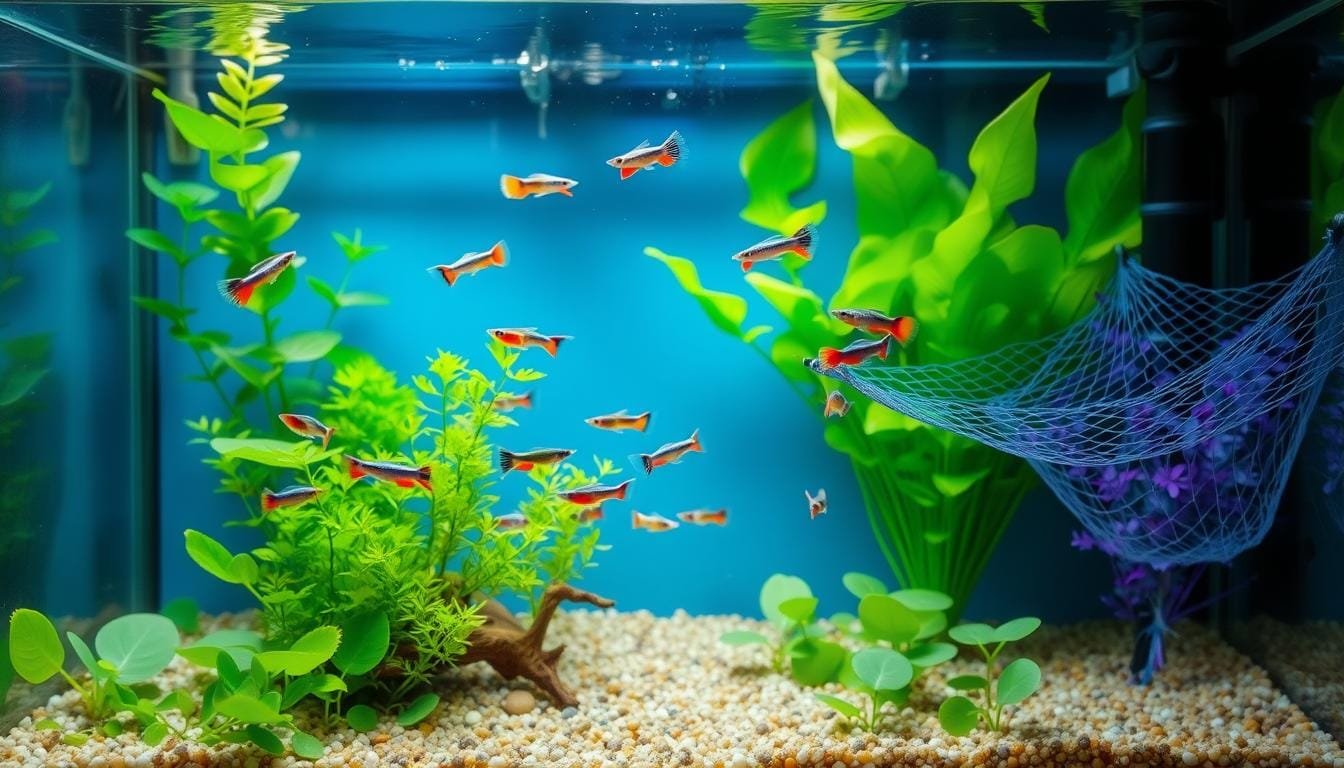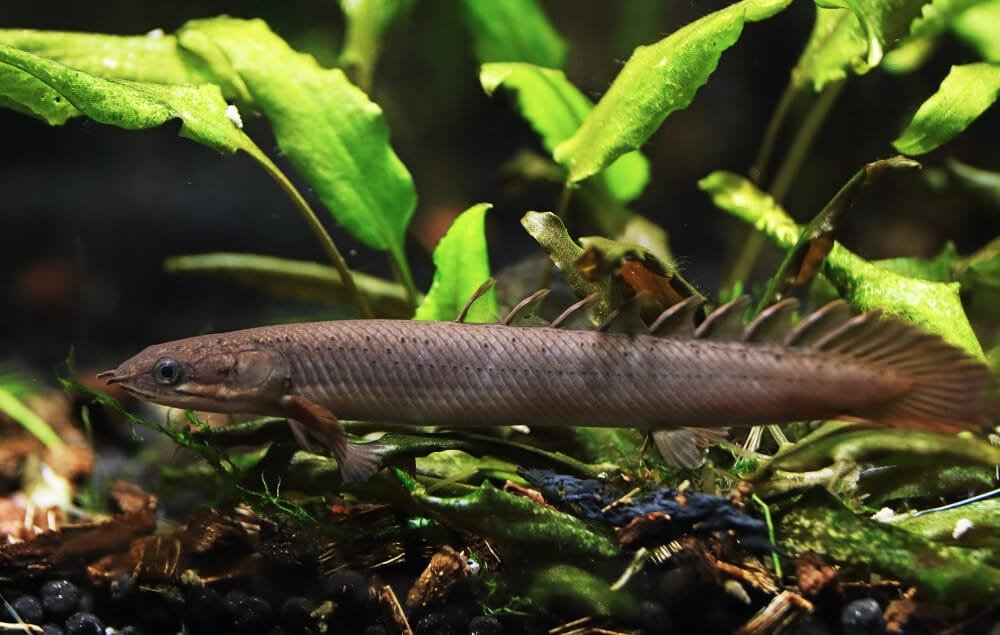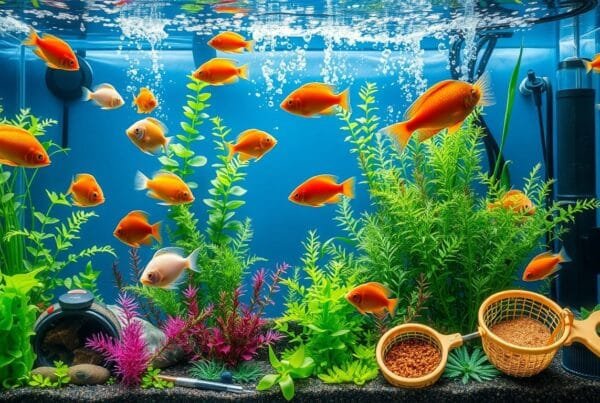Guppy breeding is a fun hobby for fish lovers of all levels. These colorful fish are easy to care for and breed quickly. You can create a lively guppy community in your home aquarium.
Female guppies can give birth to up to 80 babies at once. These tiny fish grow to 6 cm long and live about two years.
This guide covers everything you need to know about guppy breeding. You’ll learn about tank setup, water quality, and choosing the best breeding pairs.
We’ll explore the diverse colors and patterns of guppies. You’ll discover how to care for baby guppies and maintain a healthy population.
Get ready to dive into the exciting world of guppy breeding. Let’s uncover the secrets of raising these fascinating little fish!
Understanding Guppy Fish
Guppies (Poecilia reticulata) are small, vibrant freshwater fish that captivate aquarium fans. These hardy fish hail from South America and have been bred for nearly 100 years. Their easy care and bright colors make them popular with all fishkeepers.
Guppy Characteristics and Requirements
Guppies show clear differences between males and females. Females can grow up to 2½ inches long, while males reach about 1½ inches. Female guppies can start breeding when they’re just 1 inch long.
These fish do well in a pH range of 7.0 to 8.0. They prefer water temperatures between 72°F and 78°F (22°C to 26°C). Guppies are tough and can adapt to many water conditions.
To keep guppies healthy and breeding, follow these tips:
- Maintain a stable water temperature between 72°F and 78°F (22°C to 26°C)
- Keep the pH level between 7.0 and 8.0
- Perform regular water changes to maintain clean and healthy water
- Provide adequate filtration and aeration to support good water quality
Ideal Tank Size for Guppies
Guppies need enough space for their active lifestyle and breeding habits. A 10-gallon tank is the minimum size for a small group of guppies. Larger tanks offer more stable water conditions and a healthier environment.
| Tank Size (Gallons) | Recommended Number of Guppies |
|---|---|
| 10 | 6-8 |
| 20 | 12-16 |
| 30 | 18-24 |
| 40 | 24-32 |
Guppies are noted for their hardiness and can survive in a wide variety of water conditions, leading to their popularity among beginner fishkeepers.
By meeting guppy needs and providing the right tank size, you’ll create a thriving home for these fish. This setup will help ensure their health, happiness, and successful breeding.
Setting Up the Perfect Guppy Tank
Creating an ideal home for guppies is crucial for their well-being and breeding success. Consider tank size, filtration, and decorations when setting up a guppy tank. These factors help mimic their natural habitat.
Choosing the Right Aquarium
A 10-gallon tank is the minimum size for guppies. This follows the rule of 1 gallon per inch of fish. Guppies grow to about 2 inches long.
A 10-gallon tank can comfortably house a small group of these colorful fish.
Essential Equipment for Guppy Tanks
Install a gentle filter that circulates water 5 times per hour. For a 10-gallon tank, choose a filter that moves 50 gallons hourly. Avoid strong currents that may stress your guppies.
Use a heater to keep water between 75 and 80 degrees Fahrenheit. Provide 8 hours of light and 16 hours of darkness daily. This lighting schedule promotes proper rest for your guppies.
| Parameter | Recommended Value |
|---|---|
| Tank Size | Minimum 10 gallons (40 liters) |
| Water Temperature | 75-80°F (24-27°C) |
| pH Level | 7.0-7.5 |
| Water Change Frequency | Every 2 weeks |
| Water Change Amount | 20-30% of tank volume |
Decorating the Guppy Tank
Add fine gravel or sand as substrate, 2 to 3 inches deep. Include live or artificial aquarium plants for hiding spots. This setup reduces stress and promotes healthy breeding.
A well-designed guppy tank should mimic their natural habitat, providing a stress-free environment that encourages natural behaviors and successful breeding.
Choose the right tank size and essential equipment. Add plants and hiding spots. These steps create a perfect home for your guppies to thrive and reproduce.
Maintaining Optimal Water Conditions
Keeping guppies healthy requires optimal water conditions in their tank. Monitor and adjust key water parameters regularly. This creates a thriving environment for vibrant colors, active swimming, and successful breeding.

Ideal Water Parameters for Guppies
Guppies thrive in specific water conditions similar to their natural habitat. Aim for these water parameters to keep your guppies healthy and vibrant:
- pH Level: 7.0-8.0 (slightly alkaline)
- Water Temperature: 76-78°F (24-25°C)
- Water Hardness (dGH): 8-12
Test your tank water often using a reliable kit. Ensure these parameters stay stable. Small changes are normal, but big shifts can stress your guppies.
| Parameter | Ideal Range | Effects of Deviation |
|---|---|---|
| pH Level | 7.0-8.0 | Stress, reduced immunity |
| Water Temperature | 76-78°F (24-25°C) | Reduced lifespan, slower growth |
| Water Hardness (dGH) | 8-12 | Stunted growth, poor coloration |
Importance of Regular Water Changes
Regular water changes are vital for guppy water quality. They prevent harmful toxin buildup. Follow these tips for the best tank care:
- Change 20-30% of the tank water every two weeks
- Use a gravel vacuum to remove debris and uneaten food
- Replace the removed water with dechlorinated, temperature-matched water
Consistent water changes help maintain stable parameters. This reduces stress on your guppies. It also promotes a healthy, thriving aquarium environment.
“The key to success in guppy breeding lies in maintaining optimal water conditions through regular monitoring and diligent care.”
Focus on water quality and regular tank maintenance. This creates a healthy home for vibrant guppies. Your aquarium will be full of joy and beauty for years to come.
Selecting Healthy Guppies for Breeding
Choosing the right breeding pair is key to guppy breeding success. Pick vibrant, disease-free adult guppies with desirable traits and colors. Look for active fish with full fins and no signs of illness.
For optimal fish health, maintain a balanced male-to-female ratio in your breeding pair setup. Use one male for every two or three females. This lets males pursue females without overwhelming them.
- Vibrant colors and patterns that align with your breeding goals
- Robust body structure and well-proportioned fins
- Active swimming behavior and good appetite
- No signs of disease, such as fin rot, ich, or dropsy
Source your breeding stock from reputable breeders or pet stores to maintain genetic diversity. This helps avoid inbreeding issues. Keep detailed records of your breeding observations, including each guppy’s lineage.
| Factor | Recommendation |
|---|---|
| Male-to-female ratio | 1 male for every 2-3 females |
| Breeding age | 4 months or older |
| Health indicators | Active, vibrant, disease-free |
| Genetic diversity | Source from multiple breeders |
A successful guppy breeding program starts with the careful selection of healthy, genetically diverse breeding pairs that showcase the desired traits and colors.
Focus on these key aspects of guppy selection to build a thriving breeding colony. This approach will boost your chances of guppy breeding success.
Feeding Guppies for Vibrant Colors and Health
A balanced diet is key for healthy, colorful guppies. Proper nutrition ensures optimal growth and development. Let’s explore the best guppy food options and feeding practices.
High-Quality Guppy Food Options
Choose guppy-specific pellets or flakes with balanced nutrients. Look for foods rich in protein, vitamins, and minerals. These support overall health and enhance colors.
Feed adult guppies small amounts 2-3 times daily. Fry need more frequent feeding, about 3-5 times a day.
| Food Type | Protein Content | Feeding Frequency (Adults) | Feeding Frequency (Fry) |
|---|---|---|---|
| High-quality pellets/flakes | 40-50% | 2-3 times daily | 3-5 times daily |
Supplementing with Live and Frozen Foods
Boost colors and nutrients by adding live or frozen foods. Great options include brine shrimp, daphnia, and bloodworms.
- Brine shrimp
- Daphnia
- Bloodworms
These protein-rich foods stimulate guppies’ natural hunting instincts. Live food can enhance fry production during breeding. Always thaw frozen foods before feeding.
Supplementary nutrition should include live or frozen foods such as brine shrimp, daphnia, and bloodworms to enhance colors.
A well-rounded fish diet keeps guppies healthy and vibrant. Combine quality staple foods with live or frozen options. This approach helps create a thriving, stunning guppy community.
How Do I Breed Guppies
Breeding guppies is thrilling for aquarium lovers. Success requires the right setup and knowledge. Let’s explore key aspects of breeding guppies, from choosing pairs to caring for fry.
Choosing the Right Breeding Pair
Pick healthy, vibrant guppies with desired traits. Buy trios: one male and two females. Choose 3-4 month old fish for easier shipping and adjustment.
Guppies breed best between 3 and 7 months of age. This is their peak breeding period.
Setting Up a Dedicated Breeding Tank
A special breeding tank is vital. Use a 5 to 20-gallon tank with a sponge filter. Add plants or decorations for hiding spots.
Keep water at 78℉ and change 20-30% weekly. This ensures ideal conditions for breeding.
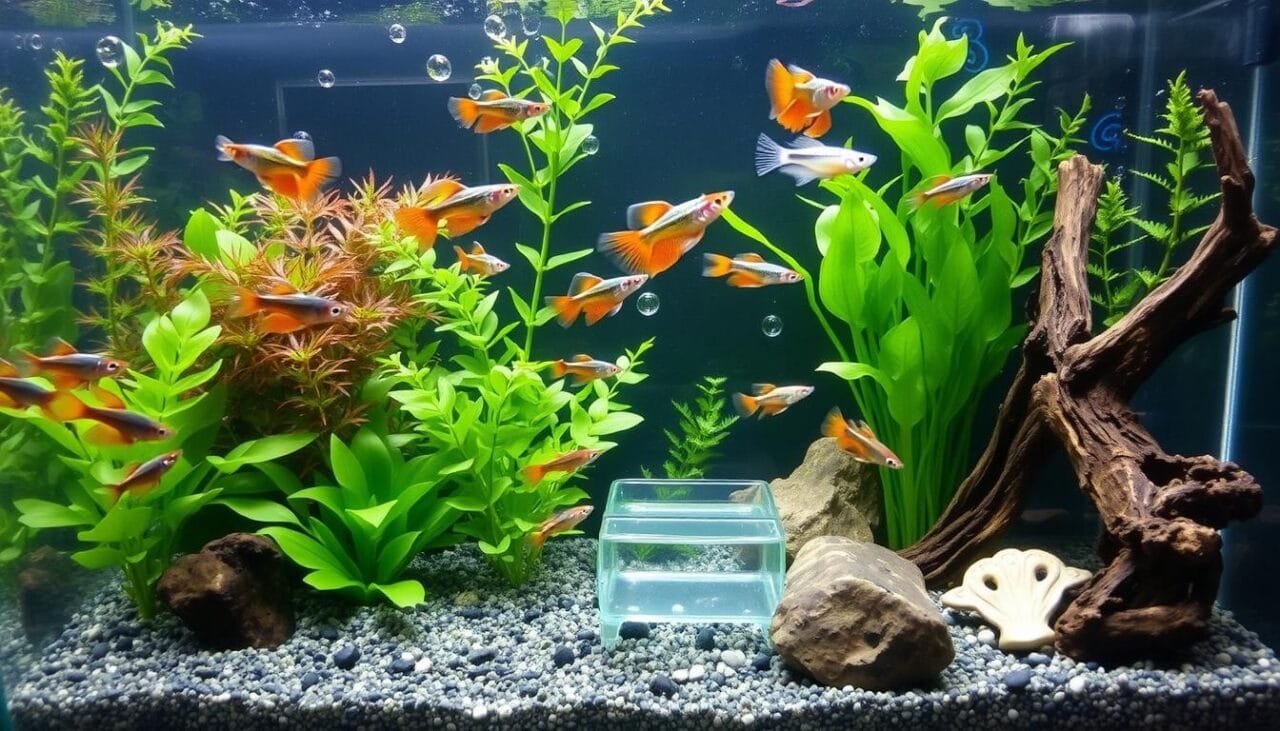
Recognizing Signs of Guppy Pregnancy
Female guppies can store sperm for multiple births. Their pregnancy lasts about 21-30 days. Look for a dark spot near the anal fin.
Expect fry within 4-6 weeks after placing females in the breeding tank. This is when they typically give birth.
Caring for Guppy Fry
Remove adult fish after birth to protect fry. Feed fry powdered flakes and provide hiding spots. Gradually offer larger food as they grow.
Keep water clean with frequent changes. This helps fry survive and grow well.
| Age | Tank Size | Stocking Density |
|---|---|---|
| Newborn to 2 months | 10 gallons | 10-20 fry per tank |
| 2 months and older | 10 gallons | 1 fish per gallon |
Use aquarium lights 10-12 hours daily. This helps fry grow and develop color. Move 3-month-old fry to a new tank.
Remember, keeping records is crucial for identifying successful breeding lines. Document the number of young, the ratio of males to females, and the number of culls for each drop.
Common Guppy Breeding Challenges and Solutions
Guppy breeding can be exciting and rewarding, but it has its challenges. Overcrowding and fry predation are common issues. Let’s explore how to manage these problems effectively.
Preventing Overcrowding in Guppy Tanks
Guppies breed rapidly, with females producing about 20 fry monthly. Two female guppies can lead to 200 fish in just 5 months. Here are tips to prevent overcrowding:
- Maintain a balanced male-to-female ratio of 1:3 to reduce stress on females.
- Regularly rehome or sell excess fry to control population growth.
- Provide a minimum tank size of 40 liters (10.56 US gallons) for about 10-12 guppies.
- Perform regular water changes and maintain optimal water parameters.
Dealing with Guppy Fry Predation
Guppy fry are at risk of being eaten, even by their parents. To protect the young and boost breeding success, try these tips:
- Provide ample hiding spots, such as dense plants or breeding traps, for fry to seek refuge.
- Promptly remove adult guppies after the fry are born to prevent predation.
- Feed fry with powdered or crushed flakes that can be easily consumed.
- Consider setting up a separate breeding tank to protect fry from adult guppies.
| Breeding Success Tips | Breeding Dos and Don’ts |
|---|---|
|
|
By using these strategies, you can overcome common guppy breeding challenges. Focus on keeping tanks in top shape and caring for fry. Manage your guppy population responsibly for a thriving community.
Guppy Varieties and Strains
Guppies come in an amazing array of colors, patterns, and tail shapes. Selective breeding has created diverse guppy types with unique traits. These fish are a favorite among aquarium lovers.
Each guppy variety boasts its own special features. These include color patterns, fin shapes, and body sizes. Mutt guppies are a common type with interesting traits.
Male mutt guppies grow to about 1.5 to 2 inches long. Females are larger, reaching 2.5 to 3 inches. With good care, these fish can live 2 to 3 years.
Popular Guppy Types and Their Characteristics
Some of the most popular guppy varieties include:
- Cobra Guppies: Known for their distinctive cobra-like pattern on their tail fins.
- Moscow Guppies: Characterized by their vibrant, metallic colors and flowing tail fins.
- Delta Tail Guppies: Recognized by their triangular-shaped tail fins that resemble the Greek letter delta.
- Half Moon Guppies: Boast a wide, rounded tail fin that resembles a half moon.
- Metallic Guppies: Exhibit a shimmering, iridescent appearance due to their metallic scales.
Developing New Guppy Strains through Selective Breeding
Breeders create new guppy strains by choosing fish with desired traits. They breed these fish together over many generations. This process leads to new strains with unique features.
Maintaining genetic diversity is crucial when developing new strains. Breeders introduce new bloodlines and avoid inbreeding. This helps prevent genetic defects and keeps offspring healthy.
For breeding, it’s best to keep one male for every 2-3 females. This ratio prevents too much stress on female guppies from excessive mating.
| Guppy Variety | Key Characteristics |
|---|---|
| Cobra Guppies | Cobra-like pattern on tail fins |
| Moscow Guppies | Vibrant, metallic colors and flowing tail fins |
| Delta Tail Guppies | Triangular-shaped tail fins resembling the Greek letter delta |
| Half Moon Guppies | Wide, rounded tail fin resembling a half moon |
| Metallic Guppies | Shimmering, iridescent appearance due to metallic scales |
Exploring guppy varieties offers endless possibilities for aquarium fans. With so many options, you can create a stunning underwater display that fits your style.
Maintaining a Thriving Guppy Community
Regular tank maintenance is key for a healthy guppy community. Perform frequent water changes and clean the tank. Keep proper filtration and monitor water quality closely.
Guppies thrive in water with a pH of 7.0-8.0. The ideal water hardness (dGH) is 8-12. Optimal temperature range is 76-78°F (24-25°C) for fish health.
Higher temperatures may speed up growth and breeding. However, this can shorten their lifespan to about 18 months. Lower temperatures may extend lifespan but slow growth and breeding.
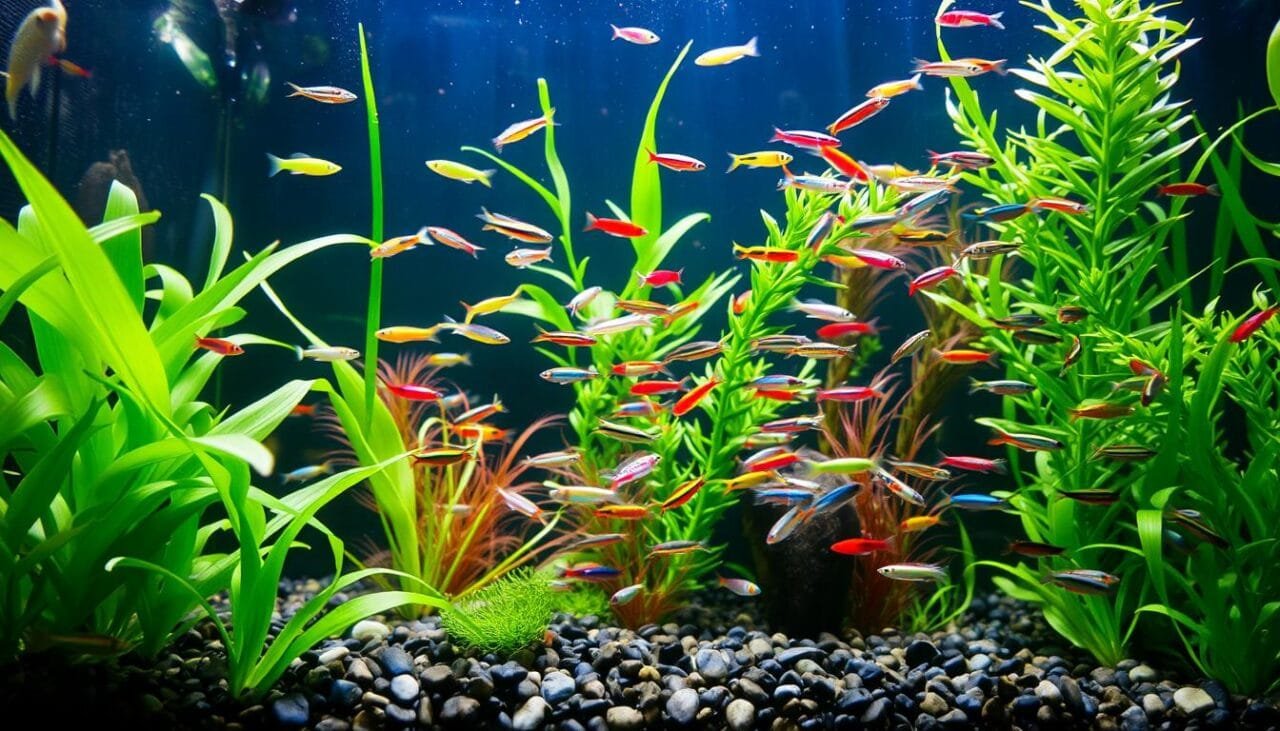
Avoid overcrowding to prevent aggression and ensure guppy survival. A 10-gallon tank can house six guppies. Larger tanks of 20-50 gallons provide better living conditions.
For breeding, maintain a ratio of one male to two or three females. This balance helps keep the population stable and healthy.
| Tank Size (Gallons) | Recommended Guppy Population |
|---|---|
| 5 | 1 male, 2 females |
| 10 | 2 males, 4 females |
| 20 | 3-4 males, 6-8 females |
| 50 | 7-8 males, 14-16 females |
A balanced diet is crucial for vibrant colors and overall health. Feed adult guppies once or twice daily for one minute. Fry need smaller, more frequent meals.
“The key to a thriving guppy community is maintaining optimal water conditions, providing a balanced diet, and ensuring a suitable population density.”
Select the healthiest guppies for breeding to enhance their qualities. Focus on these aspects to create a flourishing aquatic environment. Your beloved fish will thrive and live longer.
Troubleshooting Common Guppy Health Issues
Guppies are hardy fish but can face health problems without proper care. Learn about common issues like fin rot, dropsy, and ich. Prevent diseases by maintaining good water conditions and quarantining new fish.
Identifying and Treating Fin Rot in Guppies
Fin rot often stems from poor water quality and stress. Look for damaged fins, discoloration, and tattered edges. Keep water clean and avoid overcrowding to prevent fin rot.
If you spot signs, isolate the affected fish quickly. Treat them with the right medications to help recovery.
Preventing and Managing Guppy Dropsy
Dropsy is a serious bacterial infection causing swollen bodies and raised scales. It can cause major internal damage before symptoms show. Maintain ideal water conditions with pH between 5.5 and 8.5.
Don’t overfeed your guppies. If dropsy is suspected, isolate the fish. Seek advice from a vet who specializes in fish health.
Dealing with Ich in Guppy Tanks
Ich, or white spot disease, is caused by Ichthyophthirius multifiliis. It appears as tiny white spots on the fish’s body. Infected guppies may struggle to eat, breathe rapidly, and seem tired.
Keep tank temperature and pH levels stable to prevent ich. If it occurs, treat the whole tank with proper medications. Follow dosage instructions carefully.
| Disease | Symptoms | Prevention |
|---|---|---|
| Fin Rot | Damaged fins, discoloration, tattered edges | Maintain proper water quality, avoid overcrowding |
| Dropsy | Swollen body, raised scales | Maintain ideal water conditions, avoid overfeeding |
| Ich | White spots on body and fins, rapid breathing, fatigue | Maintain stable temperature and pH levels |
The key to healthy guppies is excellent water quality and a balanced diet. Watch your fish closely for signs of illness. Address health concerns quickly to keep your guppy community thriving.
Guppy Breeding as a Rewarding Hobby
Guppy breeding fascinates aquarium enthusiasts with its vibrant colors and unique patterns. It’s an accessible hobby with low entry costs. Many start with small, undemanding tanks, making it perfect for beginners.
Breeding guppies opens a world of discovery and creativity. Hobbyists can develop unique strains through selective breeding. They focus on traits like long fins, unusual colors, and distinctive patterns.
Linebreeding and inbreeding help produce pure strains. Typically, linebreeding requires three generations before crossing. This process allows breeders to refine desired characteristics.
For breeding success, maintain optimal water conditions. A 25-liter tank suits a breeding trio well. For growing, 36-45 liters is ideal.
Guppies thrive in water with a pH of 7.2. The normal range is 6.8-7.8. They prefer a hardness of 8-12 degrees GH.
Joining Guppy Clubs and Communities
Guppy clubs and guppy communities connect passionate breeders worldwide. These groups offer knowledge, support, and resources for all skill levels. You can learn from experts and stay updated on latest trends.
Engaging with these communities enhances your breeding experience. You’ll gain insights, share experiences, and even join exciting events and competitions.
Participating in Guppy Shows and Exhibitions
Guppy shows and exhibitions let you showcase your prized fish. Compete with other hobbyists and display your breeding results. These events provide valuable feedback from judges and fellow enthusiasts.
Participating in shows motivates you to improve. It pushes you to refine your skills and develop stunning guppy varieties.
“Guppy breeding is not just a hobby; it’s a journey of creativity, dedication, and the joy of watching these incredible fish thrive under your care.” – A passionate guppy breeder
Conclusion
This guide covers essential aspects of guppy care and breeding. You can create a thriving guppy community by understanding their needs. Set up an ideal tank environment and maintain optimal water conditions.
Use a 10-gallon tank for a small group of guppies. Keep pH between 7.0 and 7.5. Maintain water temperature at 75-80°F (24-27°C). Change 20-30% of water every two weeks.
Choose healthy guppies for breeding. Keep one male for every 2-3 females. Feed them a balanced diet with live and frozen foods. This ensures vibrant colors and good health.
Guppy females have a 21 to 30-day gestation period. Be ready to care for the fry when born. A female can give birth to 20-100 fry at once.
Watch out for common challenges like overcrowding and fry predation. Be aware of health issues such as fin rot, dropsy, and ich. Stay informed to overcome these obstacles.
Join local guppy clubs to expand your knowledge. Participate in shows and contribute to new guppy strains. With dedication, you’ll create a stunning guppy community in your aquarium.
FAQ
What is the ideal tank size for guppies?
A 10-gallon tank suits a small guppy group. Larger tanks offer more breeding space and stable water conditions.
What water parameters should I maintain for guppies?
Guppies thrive in 74-82°F freshwater with a pH of 6.8-7.8. Monitor and maintain water hardness levels regularly.
How often should I perform water changes in my guppy tank?
Change 20-30% of water weekly to remove toxins. Use a test kit to track ammonia, nitrite, and nitrate levels.
What should I feed my guppies for optimal health and color?
Use high-quality guppy-specific pellets or flakes as staple food. Add live or frozen foods like brine shrimp for proteins and color enhancement.
How do I set up a dedicated breeding tank for guppies?
Choose a healthy male and female pair for the breeding tank. Include a sponge filter and hiding spots. Ensure gentle water flow and optimal conditions.
How can I prevent guppy fry predation?
Provide dense plants or breeding traps as hiding spots. Remove adult guppies after fry are born to ensure survival.
What are some popular guppy strains?
Popular strains include Cobra, Moscow, Delta Tail, Half Moon, and Metallic guppies. Each has unique colors, patterns, and tail shapes.
How can I prevent common guppy health issues?
Maintain good water conditions and avoid overfeeding. Quarantine new fish to prevent diseases like fin rot and ich.
Isolate and treat affected guppies promptly to stop disease spread.
How can I connect with other guppy breeders and enthusiasts?
Join local or international guppy clubs and communities. Learn from experienced breeders and stay updated on latest trends and techniques.
What are the benefits of participating in guppy shows and exhibitions?
Guppy shows let you showcase prized fish and compete with others. You’ll receive valuable feedback and improve your breeding skills.
